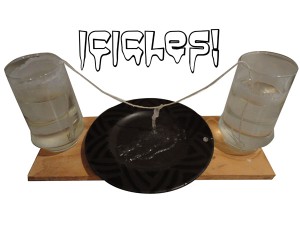Simple Science Experiments: Homemade Icicles
 Winter is upon us, and with it comes freezing weather. Well, I suppose that really depends on where you are. Some Central Florida children rarely have a chance to see snow or iconic icicles. But, this month’s simple science experiment will have your kids creating their own homemade icicles! Sure, this project may not replicate the actual way icicles form; in fact, this is how stalactites and stalagmites are created. It will, however, create a wintery feel in any home, with or without actual freezing temperatures.
Winter is upon us, and with it comes freezing weather. Well, I suppose that really depends on where you are. Some Central Florida children rarely have a chance to see snow or iconic icicles. But, this month’s simple science experiment will have your kids creating their own homemade icicles! Sure, this project may not replicate the actual way icicles form; in fact, this is how stalactites and stalagmites are created. It will, however, create a wintery feel in any home, with or without actual freezing temperatures.
Materials:
- Two tall glasses
- 2 feet of cotton string (thicker than thread)
- 2 paper clips
- water
- a plate
- Epsom salts or baking soda
- a deep bowl
Procedure:
- Pour 1 cup of Epsom salts or baking soda into a bowl.
- Add 2 cups of warm water and stir.
- You should still see chunks floating in the water. If it all dissolves, then add some more and stir it in.
- Tie the paper clips to both ends of the string. Make sure this is a thick string — more than thread, less than a shoelace.
- Put the string in the bowl of water and let it soak for an hour.
- Put two glasses about a foot apart with a small plate in between. I put a small piece of plywood underneath to hold in place (in case I had to move them).
- After an hour, pour the water from the bowl into the two glasses.
- Hang the string between the two glasses with the paper clips inside them. You want the string to loop down so that its lowest level is below the water level in the glasses.
- If there is no more Epsom salts or baking soda in the water, add a spoonful now.
- Wait a few days to see your icicles form!
Explanation:
When you dissolve a solid in water, it will flow with it. We “saturated” the water in the bowl with Epsom salts or baking soda, meaning the water dissolved as much material as it could. We soaked the string in the liquid so that when we hung it across the two glasses, water would continue to flow up and through the string. The water carrying the dissolved material then dripped from the lowest part of the string, but left little bits of the solid behind. This built up over time and formed the icicle shape. On the plate, the solid material also collected into little mounds.
Epsom salts or baking soda, meaning the water dissolved as much material as it could. We soaked the string in the liquid so that when we hung it across the two glasses, water would continue to flow up and through the string. The water carrying the dissolved material then dripped from the lowest part of the string, but left little bits of the solid behind. This built up over time and formed the icicle shape. On the plate, the solid material also collected into little mounds.
This is how stalactites and stalagmites form. Material inside rocks called “calcium carbonate” dissolves into water and then drips out of the ceiling of caves. The stalactites form from the ceiling and stalagmites from on the ground as the material solidifies.
Experiment further:
Will other materials form solid “icicles?” Will sugar do the same thing? Think about other materials that dissolve in water that might work. My kids had the idea to color the water (they try to put food coloring in everything)! Does that change the color of the substance? What if you put red on one side and blue on the other?
If you have questions about homemade icicles, or need tips about science fair ideas, visit www.stevedavala.com.
Steve Davala is a middle school science teacher who likes to write and work with Photoshop. He has two kids and subjects them to these science activities as guinea pig! Follow Steve on Twitter or email him at steve.davala@gmail.com.






